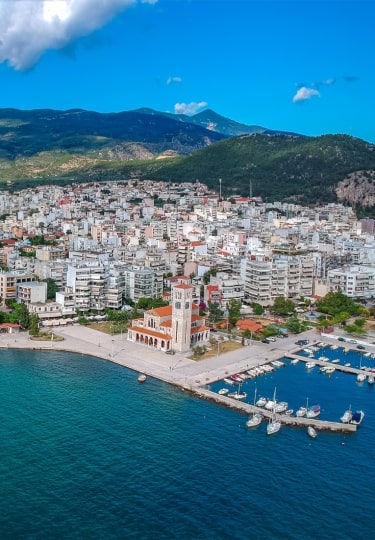Set midway between the capital Athens and the second city of Thessaloniki, Volos, Greece, is often overlooked by visitors to the country unless as a stop off while traveling between the two metropolises. That’s a real shame, as this lovely town is one of Greece’s most underrated cities.
Volos is as pretty as they come. Overlooking the golden shores of the Pagasetic Gulf which protects it from prevailing winds, and backed by towering Mount Pelion, it offers the best of both worlds thanks to its sea-to-summit location. This is the kind of place where you go hiking through forests in the morning and then chill out by the ocean in the afternoon.
Supposedly home to the legendary Centaurs, as well as Jason and his mythological argonauts, it’s a city both steeped in legend and home to ancient sites. Volos retains an elegant feel thanks to the grand residences and state buildings that line the city’s streets, and the lovely port area.
Why Visit Volos, Greece
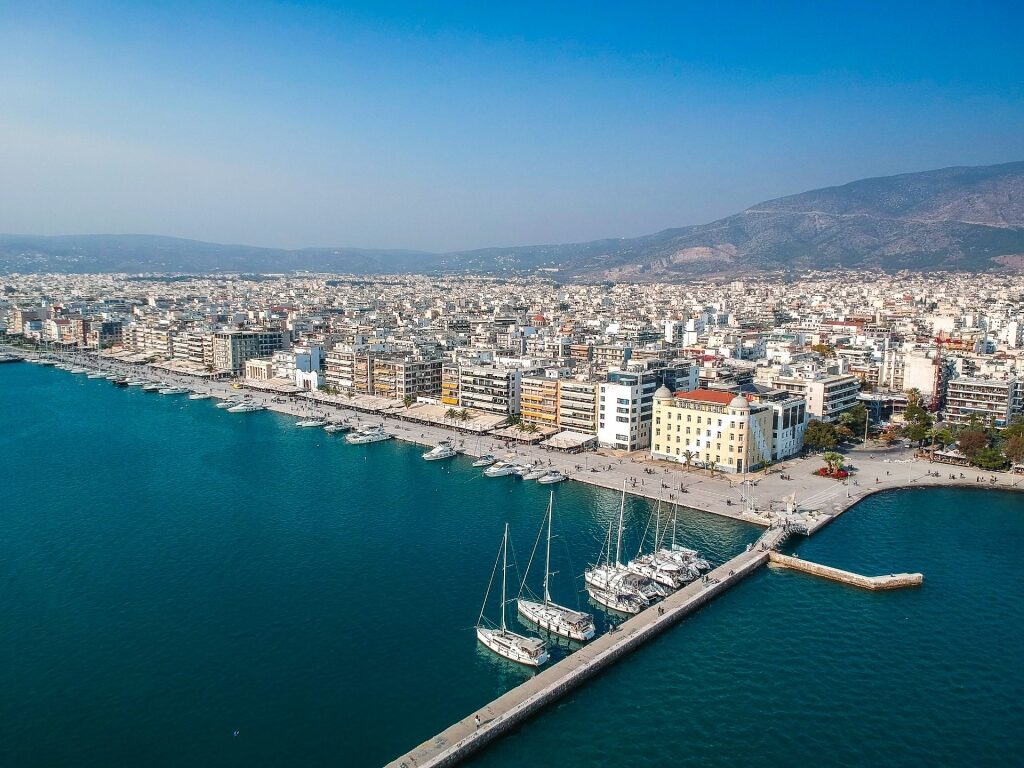
Volos
The jaw-dropping setting that greets visitors to Volos, Greece alone makes it so much more than a road stop between Athens and Thessaloniki. It offers some of the country’s loveliest beaches, gorgeous stretches of pale straw sand lapped by sparkling seas becalmed by the protection offered by the horseshoe-shaped Pagasetic Gulf.
Within minutes of leaving those shores and heading inland, you find yourself in the foothills of Mount Pelion, a vast range that stretches along the coast here for some 30 miles, topping out at 5,400 feet at its highest summit of Stavros.
Covered in chestnut, pine, and olive groves and dotted with traditional villages and elegant monasteries, Pelion is redolent with myths and legends.
Then there’s the Greek city itself. One of Greece’s busiest ports and a buzzing university town, much of the downtown area needed to be rebuilt after catastrophic earthquakes in 1955. The result is an elegant collection of restored and new homes, a magnificent harbor area lined with bars and tavernas, and some excellent museums and art galleries.
In short, if you’re looking to pack all that Greece offers into a small but perfectly formed package, Volos should be on your bucket list.
History & Culture
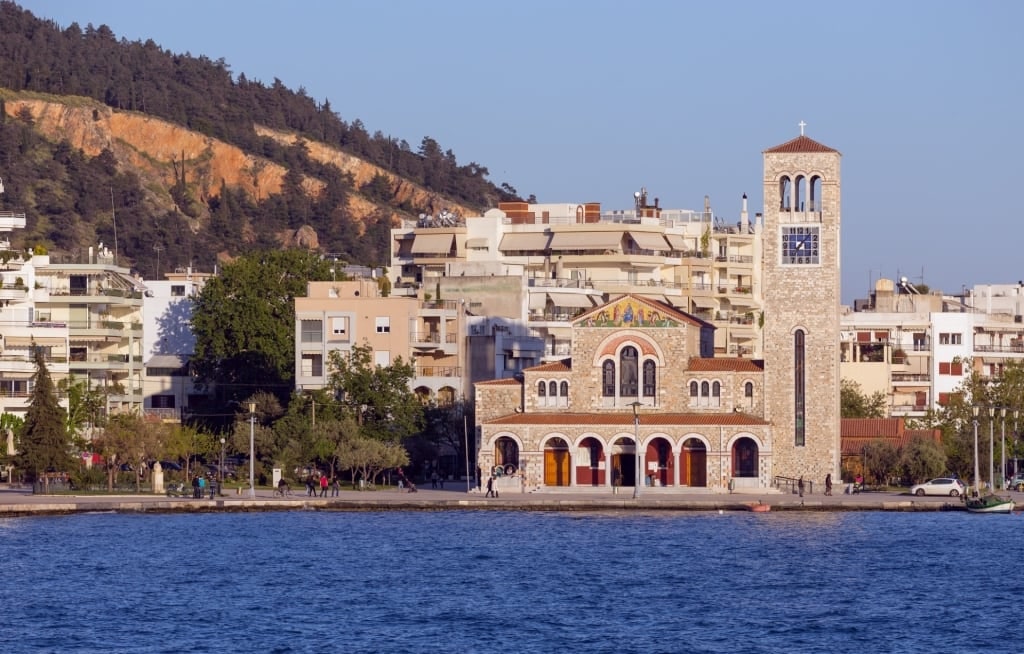
Volos
According to legend, Mount Pelion was home to the Centaurs. Chiron, one of these the legendary half-man, half-horse creatures, is said to have had Asclepius, the god of medicine, Achilles, and Jason, who led the Argonauts, under his tutelage.
Jason’s ship, the Argos, is said to have set sail to recover the Golden Fleece from the ancient city of Iolcos, thought to be modern-day Volos.
The surrounding areas are home to several archaeological sites, including Dimini, Sesklo, and Ancient Dimitriada, and their stories are told at the downtown Archaeological Museum of Volos.
For much of the Byzantine era, the city fought off raids from the pirates who marauded the Aegean in a reign of terror but it was in the late 19th century that Volos really came into its own.
In 1881, the city was ceded back to Greece by the diminishing Ottoman Empire. A sea route from the town’s port to Syria was developed, bringing much wealth thanks to the export of local goods including fresh fruit, tobacco, olives, and olive oil.
Devastating earthquakes in 1955 saw around 80 percent of the city razed to the ground and while many buildings were reconstructed, the downtown and port areas do have a modern feel to them.
Wildlife & Nature
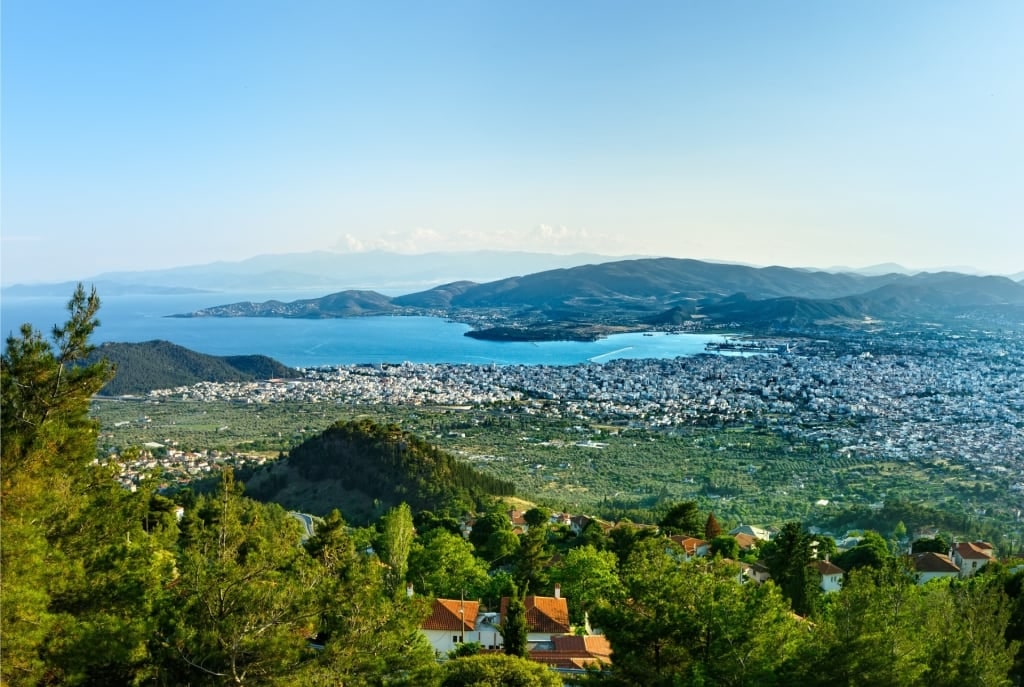
View from Mount Pelion
Volos, Greece’s location between mountain and sea means there is much to do here for lovers of the natural world. The rugged coastline of the Pagasetic Gulf makes for excellent snorkeling, diving, sailing, kayaking, and fishing, with the coast being home to a number of incredibly quaint fishing villages.
Seemingly untouched by time, they’re the kind of places where the daily schedule is set by the arrival of the fleet with its morning catch. Fishing charters can be hired from the port, while boat trips that explore emerald sea caves are also available.
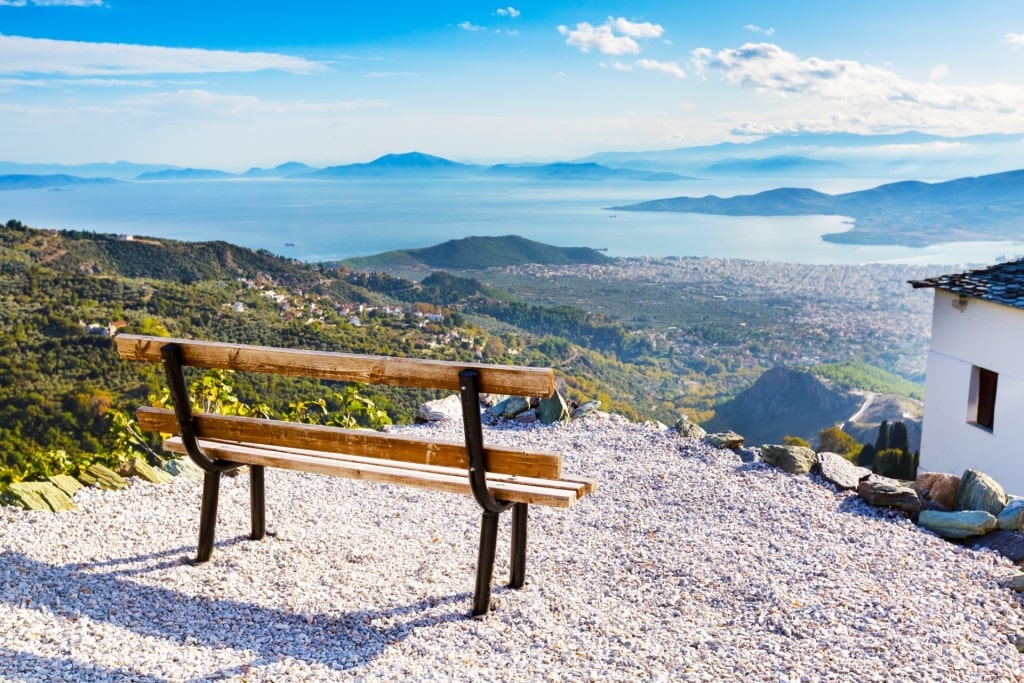
View from Mount Pelion
The foothills of Mount Pelion, meanwhile, are lined with chestnut, olive, beech, and Mediterranean pine forests, many of which are criss-crossed with ancient herding paths that make for great hiking, often through fields of wild herbs.
Badgers, hedgehogs, foxes, and wild boar may all be spotted on the ground, while lesser-spotted eagles and honey buzzards may swoop from the skies for prey.
River beds and canyons that line the mountain slopes are great spots for guided river trekking and rappelling, while mountain biking and trail running are also growing outdoor sports.
Tips for Visiting Volos, Greece
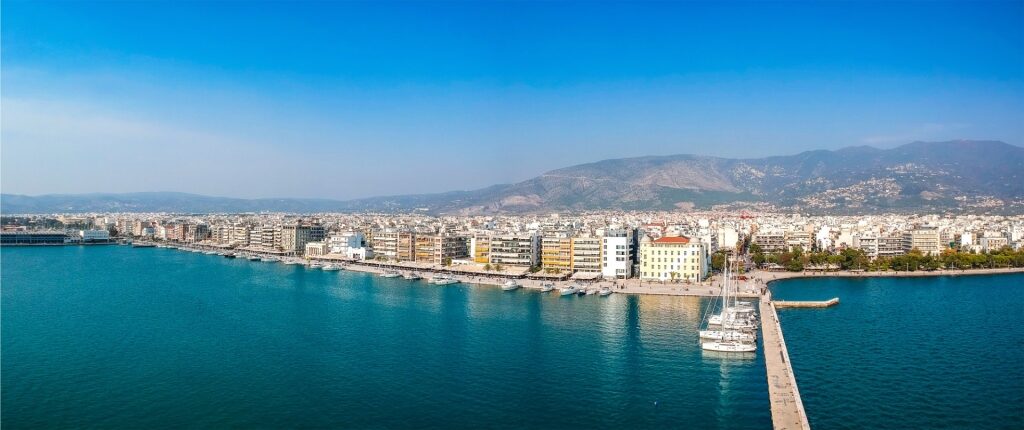
Volos
Temperatures in Greece can be extremely hot in summer, and visitors are recommended to wear hats and sunscreen, as well as to carry a plentiful supply of water and snacks, particularly when hiking or heading to the beach.
Taxis here are plentiful and relatively inexpensive. The city itself is fairly easy to navigate thanks to a grid system outside of the Old Town.
When visiting monasteries or other places of worship, visitors are advised to dress conservatively to not cause offense. Shorts and dresses should be below the knee, shoes and sandals should be closed toe, and shoulders should be covered. Some churches may offer shawls for women to cover up.
Greeks tend to love it when visitors try to learn a few words of their language. It’s unlikely, however, that the answer will come back in Greek—those working in the tourism sector love to get as much English practice as possible.
Tipping in Greece is not obligatory, but a small offering of five to ten percent is always welcomed by restaurant waiters.
Things to Do & Attractions in Volos, Greece
Take a Walk Around the Port
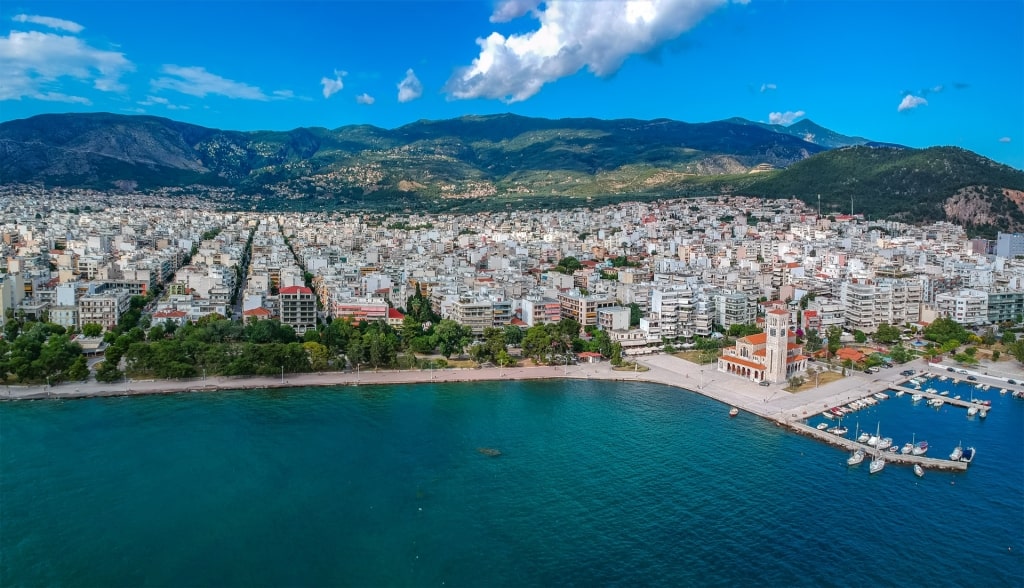
Volos Port
The port of Volos, Greece, has been a central part of the town since ancient times. Indeed, it’s from here that Jason and the Argonauts are said to have set sail in their legendary quest for the Golden Fleece.
Today, the port still bustles with activity: ferries, fishing boats, and yachts come and go in a hive of activity. The main thoroughfare is Argonauts Avenue, or Akti Argonafton, a waterfront promenade lined with palm trees, benches, and impressive floral displays.
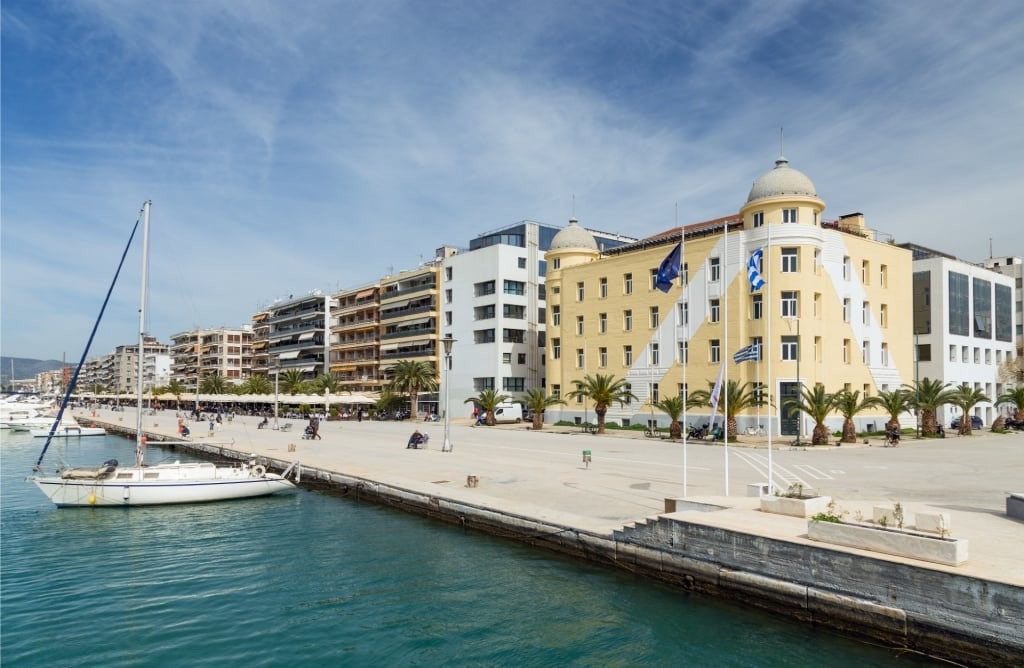
Waterfront
Cafés and restaurants run along the waterfront and it’s a great spot for people watching. Popular spots include Iolokos taverna and Senso Cocktail Bar, while a lawned park area is home to a statue dedicated to the Argonauts.
There’s also a small display that recognizes the city’s 2012 world record for the largest number of people performing the traditional Greek dance, the syrtaki.
Learn About History at the Archaeological Museum of Volos
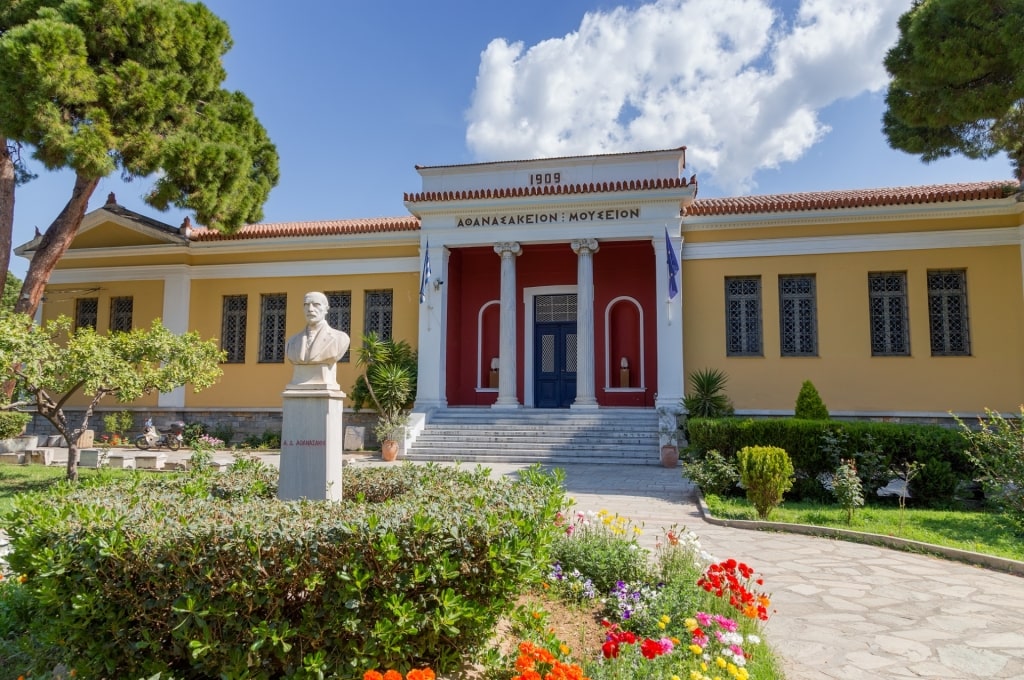
Archaeological Museum of Volos
The Archaeological Museum of Volos, Greece, is one of the oldest museums in the country, having been established in 1909. It’s set in a neoclassical building with a colonnaded front, just a block from the waterfront.
You’ll find collections from the Neolithic period, including tools and pottery from the settlements at Dimini and Sesklo, as well as exhibits from Mycenaean-era tombs, including weapons, jewelry, and pottery.
Other displays include sculptures from the Hellenistic period and beautifully preserved mosaics from Roman villas. Entry is for a nominal fee and the museum is open on most days except public holidays.
Visit Makrinitsa
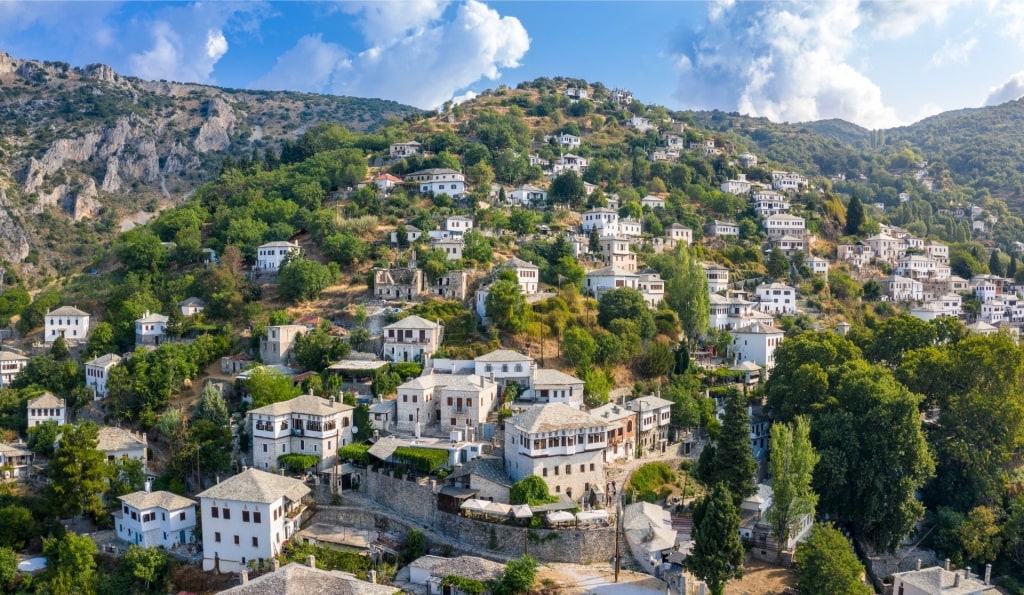
Makrinitsa
Mount Pelion has many pretty Greek villages, but perhaps none more so than Makrinitsa. Also called the “balcony of Pelion” thanks to the incredible views it offers over the Pagasetic Gulf and Volos, it perches on the hillside from around 1,000 to 2,100 feet in altitude.
Known for its traditional architecture, the cobblestone streets are lined with stone-built houses with slate roofs, surrounded by lush greenery. At its heart is the “Plateia”, or square, home to a range of cafés, tavernas, and shops, all shaded under a massive centuries-old plane tree that offers a welcome respite from the heat of summer.
Look out, too, for the elegant churches of Agios Ioannis Prodromos and Agios Athanasios, as well as the Museum of Folk Art and History of Pelion, housed in an old mansion.
Walk the Centaurs’ Path
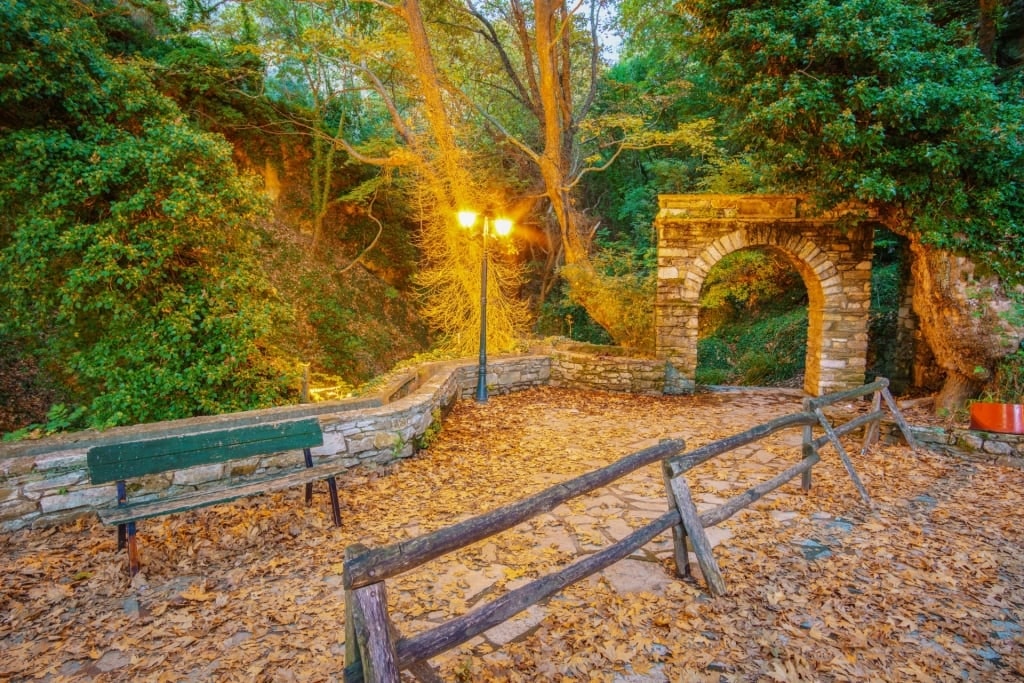
Centaurs’ Path
Starting in the village of Portaria, the Centaurs’ Path is a relatively easy hiking trail through the enchanting woods and forests of Mount Pelion.
Named after the centaurs of mythological fame, the trail follows the path of a gushing stream with small waterfalls and natural pools, and through forests filled with plane and chestnut trees.
Along the way are a series of charming stone bridges that cross over the water, as well as several picnic areas with tables and chairs. The path is suitable for most fitness levels; allow two hours to complete the circular trail.
Marvel at the Dimini Archaeological Site
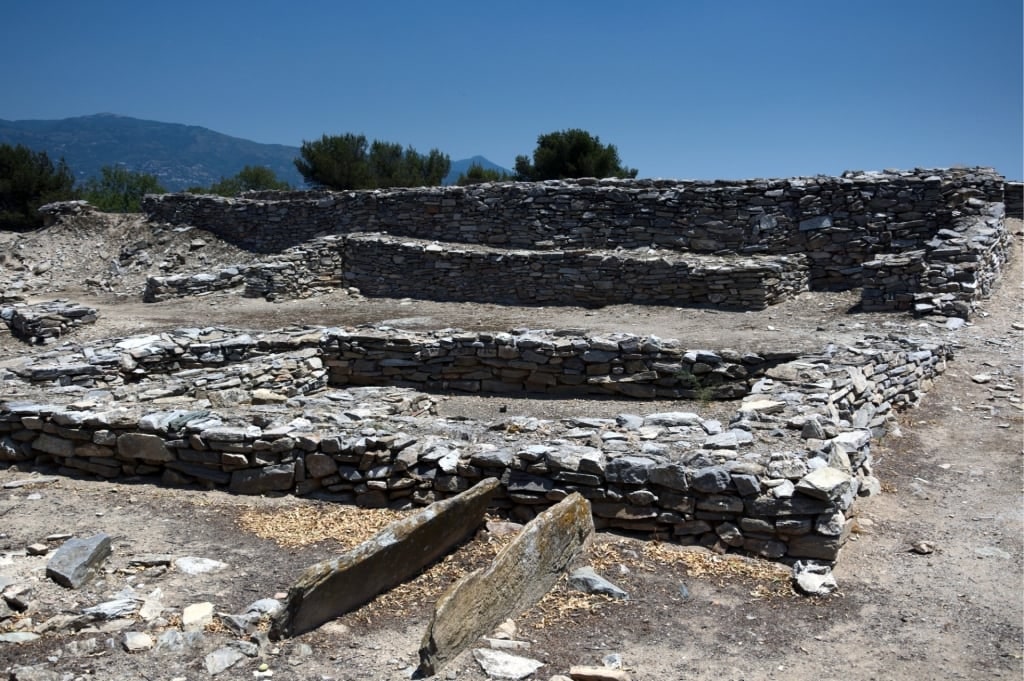
Dimini Archaeological Site Photo by Kritheus on Wikimedia Commons, licensed under CC BY-SA 4.0
Set around three miles west of the city, Dimini is home to one of the most important Neolithic sites in Greece, dating back to the 5th millennium BC.
The site consists of what appears to be a well-organized settlement with the remains of circular and rectangular stone houses set around a central court, thought to have been used for ceremonial activities.
One of the key features of a visit is the Tholos tomb, a beehive-shaped structure that served as a burial site.
Relax on the Many Beaches
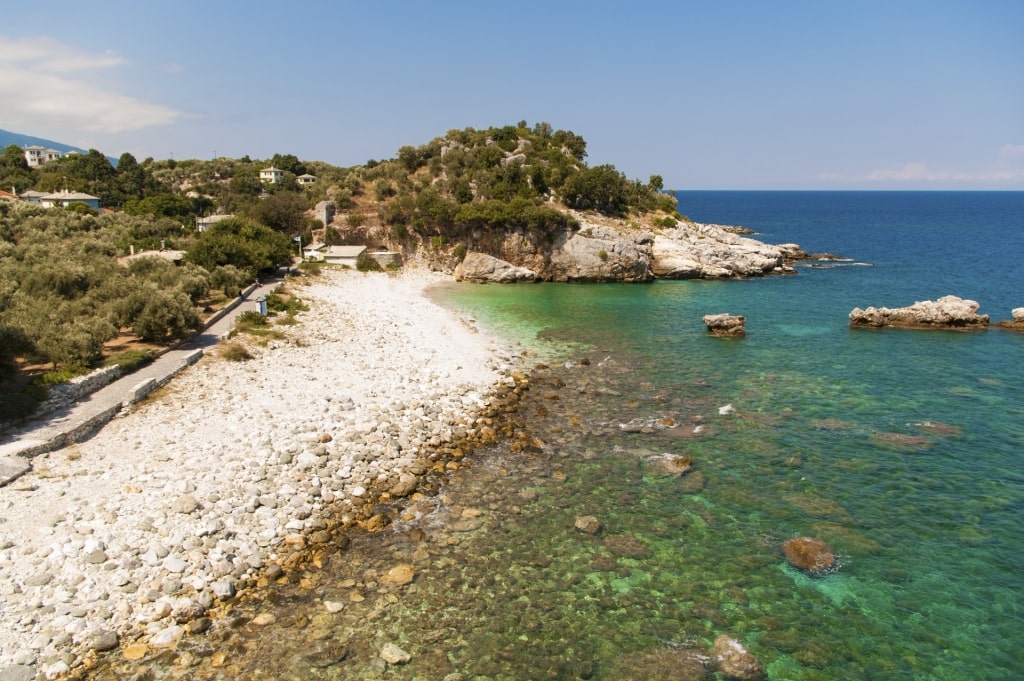
Damouchari
The Pelion Peninsula is home to some of the best beaches in Greece. Mylopotamos, home to a huge rock sculpted by the waves and winds, and Damouchari, with its white and pink pebbles, are two of the most famous.
If time is short, there are beaches on either side of the main port area that are within the city limits. Try Alykon to the west and Anavros to the east. Both have pale straw sand and good facilities.
Wonder at the Monasteries of Meteora
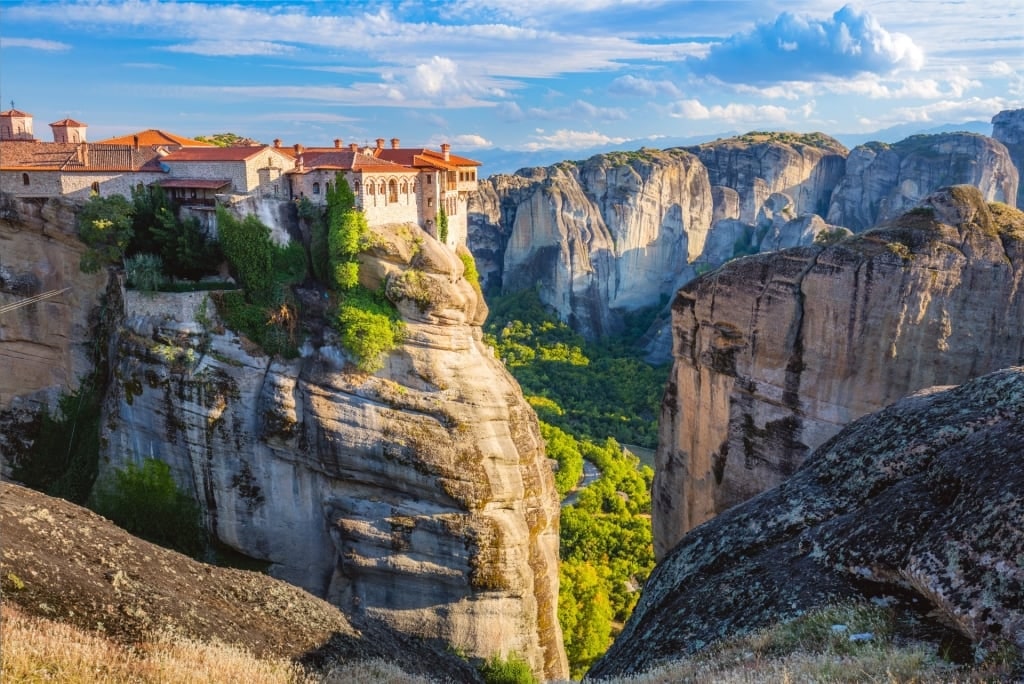
Monasteries of Meteora
Around a 90-minute drive from Volos lies one of Greece’s most impressive religious sites, the monasteries of Meteora. A UNESCO World Heritage Site, the Byzantine-era monasteries here sit atop towering rock formations, some reaching almost 1,300 feet above the ground.
The monasteries date from the 14th century when the resident monks sought refuge from the political turmoil of the time. At its height, the site was home to 24 monasteries but just six remain, all renowned for their Byzantine architecture and well-preserved frescoes that depict religious scenes, saints, and the life of Jesus Christ.
Some monasteries are easier to reach than others, and the steps to the summits can be quite steep, so plan your visit accordingly.
Food & Drink
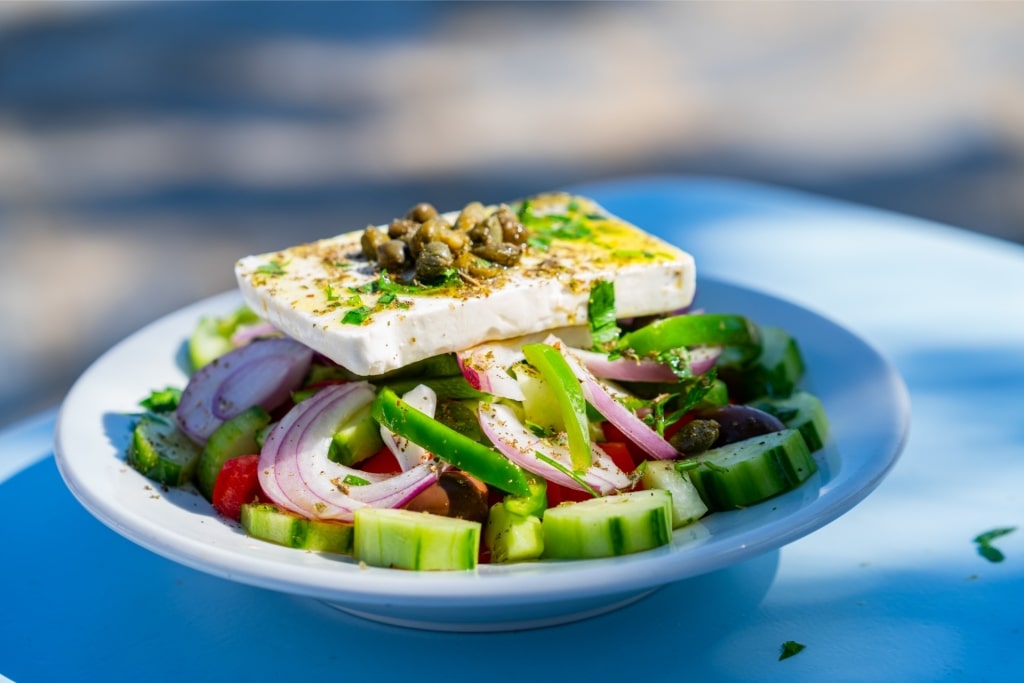
Greek salad
Eating in Volos is a typically Greek experience with some twists. Most meals tend to consist of a series of “meze” shared starters, followed by a main course, usually of meat or fish, although vegetarian options do feature on Greek menus.
Produce tends to be locally sourced; the surrounding Thessaly area is well known for its agriculture.
Specialist local tavernas in Volos are known for serving their meze, usually seafood based, with the local firewater “tsipouro”. Look out for the word “tsipouradiko”, especially around the waterfront, to sample this unique way of eating. Go easy on the potent tsipouro or prepare to rest your head the next day.
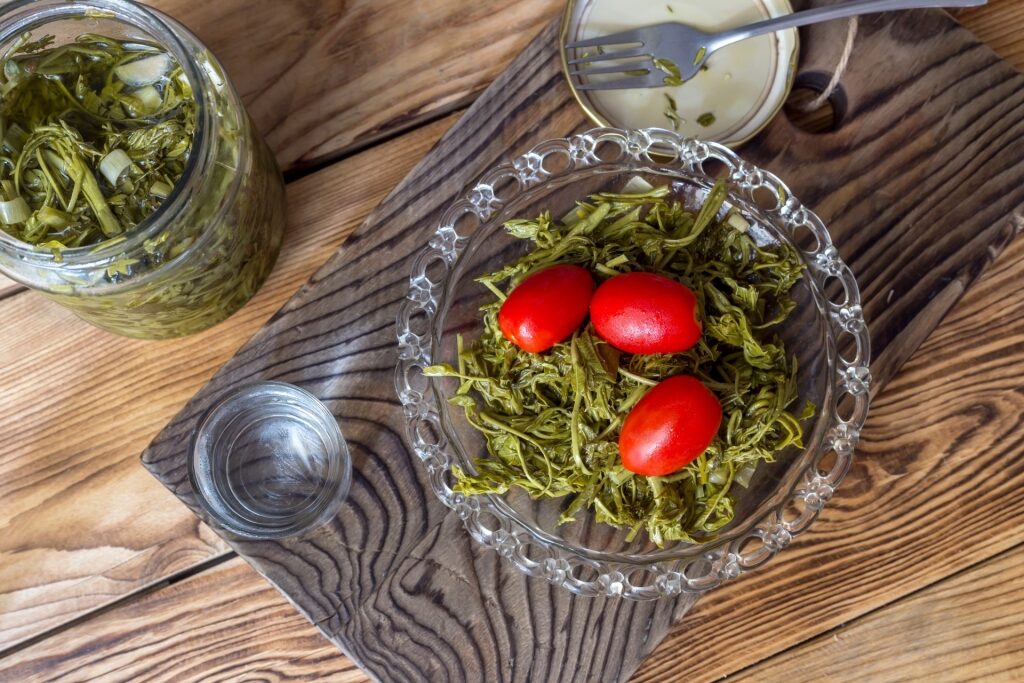
Tsitsiravla
Up in the hills of Pelion, look out for local dishes including tsitsiravla, the pickled sprouts of pistachio trees, a deep orange cheese spread known as kopanisti Volou, and spetzofai. This dish par excellence consists of just four ingredients: home-grown tomatoes, green peppers, and spicy local sausage, all simmered in olive oil.
Best Time to Visit Volos
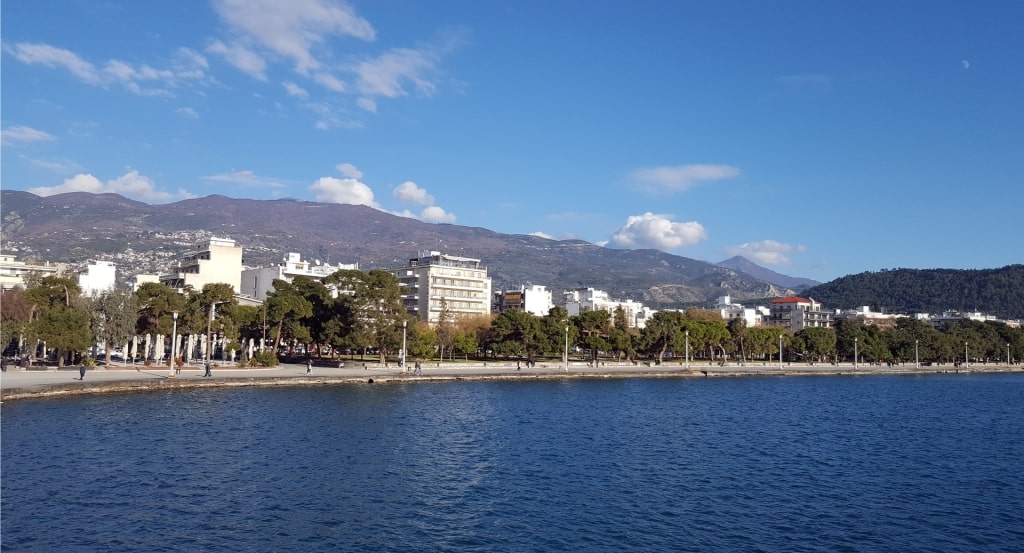
Volos
Volos, Greece, can be visited at any time. Summer is the height of season when things will be more lively, with international visitors and locals heading for the beaches.
It can be very hot though, so for those looking for fewer crowds and a more active experience, the slightly cooler shoulder seasons of spring and fall remain great options.
Read: Expert Tips for Planning a Trip to Greece
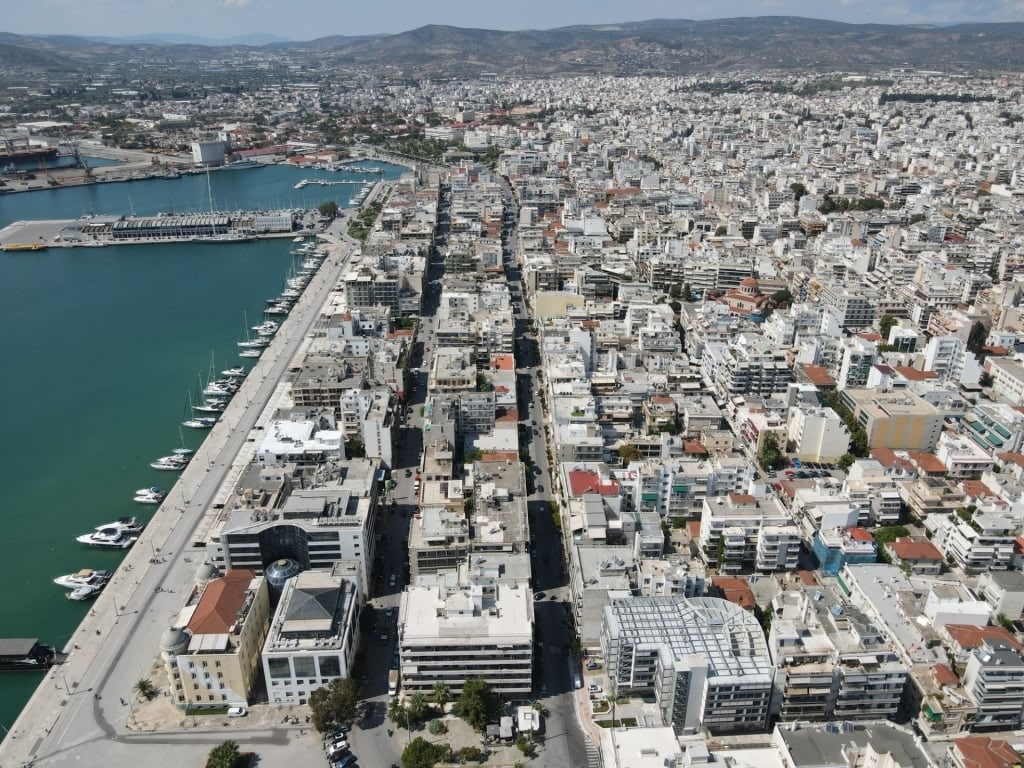
Volos
Discover your own Greek myths and legends on a thrilling vacation with Celebrity Cruises. Browse our cruises to Volos and plan your European adventure.
